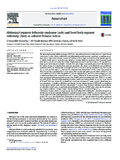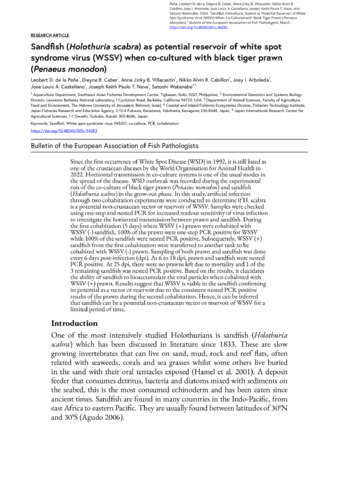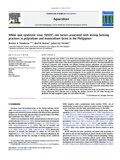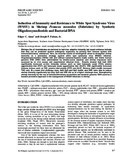Abdominal segment deformity syndrome (asds) and fused body segment deformity (fbsd) in cultured Penaeus indicus
Share
စိတ္တဇ
The abdominal segment deformity disease (ASDD) is a new shrimp disease reported only in cultured Penaeus vannamei in Thailand. Shrimp with ASDD have deformed abdominal segment, jagged gut line and bumpy surfaces. Similar signs were observed in cultured P. indicus in the Philippines. However, aside from the signs described for ASDD, some P. indicus showing abdominal segment deformity syndrome (ASDS) had more severe deformities up to the extent that the number of body segments was reduced due to fusion. Shrimp with fused body segment deformity (FBSD) had four instead of five pairs of legs. To account the prevalence of the deformities in P. indicus, shrimp were classified into grossly normal shrimp (NS), shrimp with abdominal segment deformity syndrome (ASDS) and shrimp with fused segments (FBSD). Out of the shrimp sampled, 83.4 ± 5.4% was NS, 10.9 ± 6.2% was ASDS and 5.7 ± 3.0% was FBSD. Morphometric characteristics of the shrimp were measured. There was no significant difference in body weight (BW) among male and female NS, ASDS and FBSD. In both sexes, total length (TL) of FBSD was significantly shorter compared to NS and ASDS. Shrimp samples were also screened to be negative for known infectious viral diseases including white spot syndrome virus (WSSV), infectious hypodermal and haematopoietic necrosis virus (IHHNV), infectious myonecrosis virus (IMNV), P. vannamei nodavirus (PvNV), Macrobrachium rosenbergii nodavirus (MrNV) and Taura syndrome virus (TSV). Occurrence of ASDS and FBSD in post-larvae (PL) produced from captive and wild spawners were also determined. Based on a tank experiment, no significant difference was detected between the percentages of ASDS in PL produced from wild or captive spawners but FBSD was only noted in PL produced from the latter. Deformities generally did not affect the size of P. indicus except for the reduced length of shrimp with FBSD which when coupled with missing pleopods could lead to major economic loss for shrimp farmers if not addressed properly.
Suggested Citation
Santander-Avancena, S., Estepa, F. D., Catedral, D. M., Faisan, J. P., Jr., & de la Peña, L. D. (2017). Abdominal segment deformity syndrome (asds) and fused body segment deformity (fbsd) in cultured Penaeus indicus. Aquaculture , 466, 20-25. https://doi.org/10.1016/j.aquaculture.2016.09.036
ဘာသာရပ်
aquaculture economics  ; symptoms
; symptoms  ; White spot syndrome virus
; White spot syndrome virus  ; culture tanks
; culture tanks  ; shrimp culture
; shrimp culture  ; morphometry
; morphometry  ; spawning populations; Nimaviridae
; spawning populations; Nimaviridae  ; husbandry diseases; environmental impact
; husbandry diseases; environmental impact  ; tanks
; tanks  ; marine technology
; marine technology  ; body weight
; body weight  ; viral diseases
; viral diseases  ; economics
; economics  ; viruses
; viruses  ; aquaculture
; aquaculture  ; ponds
; ponds  ; Taura syndrome virus; Decapoda
; Taura syndrome virus; Decapoda  ; Penaeus indicus
; Penaeus indicus  ; Macrobrachium rosenbergii
; Macrobrachium rosenbergii  ; Philippines
; Philippines  ; Thailand
; Thailand  ; Outbreaks; Nodavirus
; Outbreaks; Nodavirus
 ; symptoms
; symptoms  ; White spot syndrome virus
; White spot syndrome virus  ; culture tanks
; culture tanks  ; shrimp culture
; shrimp culture  ; morphometry
; morphometry  ; spawning populations; Nimaviridae
; spawning populations; Nimaviridae  ; husbandry diseases; environmental impact
; husbandry diseases; environmental impact  ; tanks
; tanks  ; marine technology
; marine technology  ; body weight
; body weight  ; viral diseases
; viral diseases  ; economics
; economics  ; viruses
; viruses  ; aquaculture
; aquaculture  ; ponds
; ponds  ; Taura syndrome virus; Decapoda
; Taura syndrome virus; Decapoda  ; Penaeus indicus
; Penaeus indicus  ; Macrobrachium rosenbergii
; Macrobrachium rosenbergii  ; Philippines
; Philippines  ; Thailand
; Thailand  ; Outbreaks; Nodavirus
; Outbreaks; Nodavirus
Taxonomic term
စုစည်းမှုများ စုစည်းမှုများ
- AQD Journal Articles [1249]
Related items
Showing items related by title, author, creator and subject.
-
Sandfish (Holothuria scabra) as potential reservoir of white spot syndrome virus (WSSV) when co-cultured with black tiger prawn (Penaeus monodon)
de la Peña, Leobert D.; Caber, Dieyna B.; Villacastin, Anne Jinky B.; Cabillon, Nikko Alvin R.; Arboleda, Joey I.; Castellano, Jose Louis A.; Nava, Joseph Keith Paulo; Watanabe, Satoshi (European Association of Fish Pathologists, 2024-03-08)Since the first occurrence of White Spot Disease (WSD) in 1992, it is still listed as one of the crustacean diseases by the World Organisation for Animal Health in 2022. Horizontal transmission in co-culture systems is one ... -
White spot syndrome virus (WSSV) risk factors associated with shrimp farming practices in polyculture and monoculture farms in the Philippines
Tendencia, Eleonor; Bosma, Roel H.; Verreth, Johan A. J. (Elsevier, 2011)White spot sydrome virus (WSSV) is one of the most important viral disease of shrimp. Several studies to control the disease have been done. Tank experiments identified WSSV risk factors related to the physico chemical ... -
Induction of immunity and resistance to white spot syndrome virus (WSSV) in shrimp Penaeus monodon (Fabricius) by synthetic oligodeoxynucleotide and bacterial DNA
Amar, Edgar C.; Faisan, Joseph P., Jr. (University of the Philippines Los Baños, 2012)Shrimps like all invertebrates are believed to lack true adaptive immunity but recent evidence indicate that they can be protected against pathogenic organisms by priming their immune system with immunostimulatory substances. ...





